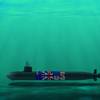Technology Propels Navigators into 21st Century Training
By Mass Communication Specialist Seaman (SW) H. Jones,
With a $3.5 million price tag, the Norfolk Navigation, Seamanship, and Shiphandling Trainer (NSST) opened June 9 after a ribbon cutting ceremony presided over by Rear Adm. Kevin Quinn, commander, Naval Surface Force Atlantic (SURFLANT).
From a plain, nondescript brick building at Naval Station Norfolk, Sailors can now travel to foreign ports around the globe, without ever even crossing a quarterdeck.
In its first successful week of operation, a brand new, state-of-the-art shiphandling simulator is proving to be an invaluable asset for improving warfighting readiness and safety among Norfolk-based Sailors, explained Lt. Cmdr. Jim Quaresimo, a training officer with SURFLANT.
During the ceremony, Quinn praised the efficiency and usefulness of the simulator, and said the trainer offers a "realistic, low-cost alternative that allows surface warriors to train to become better shiphandlers [thereby] increasing warfighting readiness."
The 6,000-square-foot facility includes two full-mission simulators, christened USS Jamestown and USS Yorktown, and a bridge-wing simulator dubbed USS Williamsburg.
The full-mission trainers are complete with a 240-degree view of any of the 17 ports stored in the memory of 23 Pentium 4 processors, explained Andy Deal, a contractor at the NSST.
Each of the simulators provide students with a realistic training environment, complete with bridge windows overlooking a giant convex screen where seven projectors provide realistic scenery, right down to the old Port of Norfolk grain elevator that can be seen from Naval Station Norfolk.
Ensign Jonathan Sieg, a trainee at the simulator, explained that the opportunity to learn from their mistakes is what makes the trainer so important.
"Going in and out of port is about the most dangerous routine evolution we do in the Navy," he said. "And as ship drivers, we need to know how to [do it safely], and this gives us the chance to learn without actually running a destroyer aground."
Last week, Capt. Ken Krogman, SURFLANT's training officer, said that although there is no substitute for real-world experience, the trainer is a "risk-free, and nearly cost-free bridge between shiphandling theory and actually getting a ship underway."
It is easy to forget that the environment is computer generated, noted Quaresimo, because of recent advancements in graphics capabilities.
"The graphics are definitely high fidelity, and they had to be," he said, referring to the Polaris II software used to run the simulations. "The young people coming into the Navy today are part of the video game generation, and they know bad graphics when they see them – so they had to be as real as possible."
Classroom time is also a part of the course, and gives the instructors, many of whom are retired Navy captains, the opportunity to explain the theories behind shiphandling.
Sieg, who said he has been through many shiphandling classes, boasted that the course was probably one of the best he'd ever been through.
According to the simulator's builders, the system costs the Navy a mere $1.40 per hour – monumentally less than the operational costs of sending a ship underway to conduct comparable training. With trainers in each of the fleet concentration areas, the Navy is saving roughly $120,000 in travel each year alone, explained Quaresimo.
This is the seventh and final simulator opened by the Navy, with sister units operating in other fleet concentration areas, including and , , and
The controlled environment allows for commanding officers to send their navigation teams to practice specific evolutions that have historically been difficult to learn.
As technology advances, the Department of Defense is turning more and more toward simulators as a viable option for preparing warfighters, medical personnel and, in the Navy's case, shiphandlers.
As the future of warfighting progresses, the Navy will continue to look into virtual training options, said Quaresimo, but only when doing so consistently provides for top-notch, first-rate training.
"As technology becomes available, we will explore it and continue to capitalize on those areas where simulation makes sense," said Quaresimo. "We want to effectively mimic what we would do with real ships, and do so at a reduced cost, while continuing to build on our core competencies as shiphandlers."










